Tensor z-Transform
Abstract
The multi-input multioutput (MIMO) systems involving multirelational signals generated from distributed sources have been emerging as the most generalized model in practice. The existing work for characterizing such a MIMO system is to build a corresponding transform tensor, each of whose entries turns out to be the individual z-transform of a discrete-time impulse response sequence. However, when a MIMO system has a global feedback mechanism, which also involves multirelational signals, the aforementioned individual z-transforms of the overall transfer tensor are quite difficult to formulate. Therefore, a new mathematical framework to govern both feedforward and feedback MIMO systems is in crucial demand. In this work, we define the tensor z-transform to characterize a MIMO system involving multirelational signals as a whole rather than the individual entries separately, which is a novel concept for system analysis. To do so, we extend Cauchy’s integral formula and Cauchy’s residue theorem from scalars to arbitrary-dimensional tensors, and then, to apply these new mathematical tools, we establish to undertake the inverse tensor z-transform and approximate the corresponding discrete-time tensor sequences. Our proposed new tensor z-transform in this work can be applied to design digital tensor filters including infinite-impulse-response (IIR) tensor filters (involving global feedback mechanisms) and finite-impulse-response (FIR) tensor filters. Finally, numerical evaluations are presented to demonstrate certain interesting phenomena of the new tensor z-transform.
1. Introduction
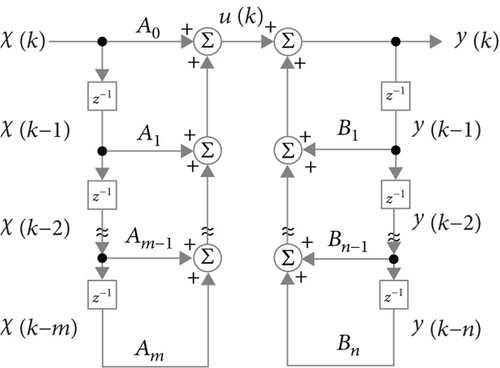
However, when a MIMO system has a global feedback mechanism as described by Eq. (1), which involves the coupling relationship among signals, the aforementioned individual z-transforms of the overall transfer tensor are quite difficult to formulate. Throughout this work, we call a MIMO system without any feedback mechanism a “feedforward MIMO system” where , , ⋯, in Figure 1 are all zero tensors (all their entries are zero); we call a MIMO system without any global feedback mechanism (Eq. (2) holds) a “local-feedback MIMO system” where not all of , , ⋯, in Figure 1 are zero tensors; at last, we call a MIMO system with global feedback mechanism(s) (Eq. (1) holds) a “global-feedback MIMO system.” Therefore, a new mathematical framework to govern all of the feedforward, local-feedback, and global-feedback MIMO systems is in crucial demand. In this work, we propose the novel “tensor z-transform” to characterize an arbitrary MIMO system involving multirelational signals as a whole rather than the individual entries separately.
Some extensions have been made from the conventional z-transform to deal with tensor signals. In [19, 20], the multidimensional z-transformation (referred to as “tensor” in [19, 20]) is introduced to rewrite convolutions and sums of convolutions as products and sums of series. Our proposed tensor z-transform is different from these works since there must involve multiple z-domain variables to characterize a tensor in different ranks in [19, 20]; the multidimensional z-transformation is adopted simply as the generating function for counting the transition probabilities [21] while it is aimed at dealing with the signal and system analysis. To the best of our knowledge, there exists no technique to extend the conventional z-transform from a sequence of complex numbers (scalar) to a sequence of tensors. The obvious difference between the tensor z-transform in this work and the D-transform in [22] is that the tensor z-transform can transform time-domain signals expressed by arbitrary multidimensional arrays (tensors) while the D-transform can only deal with the two-dimensional arrays (matrices). The main difficulty for such an extension is to establish Cauchy’s residue theorem for tensors. In this work, we first define the new tensor z-transform and discuss the related properties. Then, we generalize Cauchy’s residue theorem from scalars to tensors in order to perform the inverse tensor z-transform. Different from the power-series approach, i.e., long division, the time-domain tensor sequence obtained by taking the inverse z-transform via Cauchy’s residue theorem for tensors is not unique since it depends on what contour is chosen in the complex tensor integration. The variability to obtain different time-domain tensor sequences from a tensor z-transform can lead to a new approach to approximate time-domain tensor signal sequences with much less implementational effort from the perspectives of computation and memory complexities. The relationship between the time-domain tensor sequence obtained by applying the power-series approach and that obtained by utilizing Cauchy’s residue theorem for tensors to carry out the inverse tensor z-transform will also be established in this work. An application of tensor z-transform for digital tensor-filter design will be discussed. Besides, the frequency responses of the tensor z-transform, namely, the “ensemble magnitude response” and the “ensemble phase response,” will be investigated. Finally, numerical evaluations will be presented to demonstrate certain interesting phenomena about the tensor z-transform.
The rest of this paper is organized as follows. The concept about tensor z-transform will be introduced in Section 2. New theories regarding Cauchy’s residue theorem for tensors will be presented in Section 3. In Section 4, two approaches to carry out the inverse tensor z-transform, namely, the power-series approach and the integration approach via Cauchy’s residue theorem for tensors, will be introduced. An application of the tensor z-transform for digital tensor-filter design will be presented in Section 5. Numerical evaluations about the frequency responses of the tensor z-transform, the tensor-sequence approximation error, and the implementational complexities will be demonstrated in Section 6. The conclusion will be finally drawn in Section 7.
1.1. Nomenclature
The sets of complex and real numbers are denoted by ℂ and ℝ, respectively. The set of all integers is denoted by ℤ. The natural-number set is represented by ℕ, and ℕ≥0 denotes the set of nonnegative integers. The symbol “≝” denotes a mathematical definition. The tensor dimensionality discussed in this paper can be expressed by if it is not specified in the context. Note that ι is reserved to represent . Spectrum and eigenvalue share the same meaning throughout this work. Given two invertible tensors , , represents where “⋆M” denotes the “Einstein product” or “tensor product” as defined in [3].
2. Tensor z-Transform
In this section, we would like to introduce a new mathematical framework, namely, the tensor z-transform. The essential definitions and related examples are presented in Section 2.1 while the important properties are described in Section 2.2.
2.1. Definitions and Examples
Lemma 1 below will establish the required convergence radius of z for Eq.(4). We say a sequence of tensors is a causal tensor sequence if for n < 0, while a sequence of tensors is called an anticausal tensor sequence if for n < 0.
Lemma 1. Consider a power series in terms of the complex variable z as given by
Proof. Without loss of generality, one may assume z0 = 0. Now we will prove that the power series converges for |z| < R while it diverges for |z| > R instead. Given |z| < R and any ϵ > 0, there exists only a finite number of indices n such that . Consequently, we may have for all but a finite number of tensors , so the tensor series converges if |z| < 1/(1/R + ϵ). Therefore, the power series converges for |z| < R. On the other hand, given ϵ > 0, if we have an infinite number of tensors such that , then |z| = 1/(1/R − ϵ) > R and the tensor series cannot converge since does not converge to 0.
To illustrate the concept of the tensor z-transform, we present the following example.
Example 1. A sequence of tensors is given by where is a constant tensor. Thus, the corresponding radius of convergence is given by
The z-transform of can be obtained as
2.2. Properties
In this subsection, we will introduce several important properties about the tensor z-transform as follows. Due to page limit, we will present the basic properties related to the tensor z-transform, e.g., linearity, time delay, upsampling, and downsampling.
2.2.1. Linearity
2.2.2. Time Delay
2.2.3. Upsampling
2.2.4. Downsampling
2.2.5. Time Reversal
2.2.6. Scaling in the z-Domain
2.2.7. Complex Conjugation
2.2.8. Differentiation
2.2.9. Convolution
2.2.10. Accumulation
2.2.11. Initial Value Theorem
2.2.12. Final Value Theorem
3. Cauchy’s Residue Theorem for Tensor Sequences
It is well-known that the scalar sequence resulting from the inverse z-transform can be determined using Cauchy’s residue theorem [23]. We will extend Cauchy’s residue theorem to accommodate tensor sequences in this section.
Let us begin with Cauchy’s integral formula for tensors in the following subsection.
3.1. Cauchy’s Integral Formula for Tensors
Lemma 2 below provides the alternative expression of .
Lemma 2. Given a tensor along with its resolvent , we have
Lemma 3 below shows that the resolvent is an analytic tensor-valued function of z.
Lemma 3. Given a tensor along with its resolvent , if we have
Proof. To show that the tensor-valued function is an analytic function of z, we can express by a convergent power series. According to Lemma 2, we can express Eq. (50) by
According to Lemma 3, since the resolvent of is analytic, we can carry out the contour integrals over it. For example, a contour ℭ3 encircles a single eigenvalue, say λ3, in Figure 2(a) such that
Now we can present Theorem 4 about Cauchy’s integral formula for tensors.
Theorem 4. Given a tensor and an analytic function f(z) with the region of convergence (ROC) including , let be a contour where the set of points are all inside .
Thus, we have
where is defined by Eq. (46).
Proof. Consider a contour as illustrated by Figure 2(a) or 2(b). Thus, we have
Because f(z) is an analytic function with the ROC including , according to the spectral mapping theorem in [25] and Cauchy’s integral formula for scalars in [23], we have
Define the n-th derivative with respect to the tensor by
Corollary 5. Given a tensor together with an analytic function f(z) of z with the ROC including . Since is a contour where the set of points are all inside , we have
Proof. For n = 1 (the first-order derivative), we have
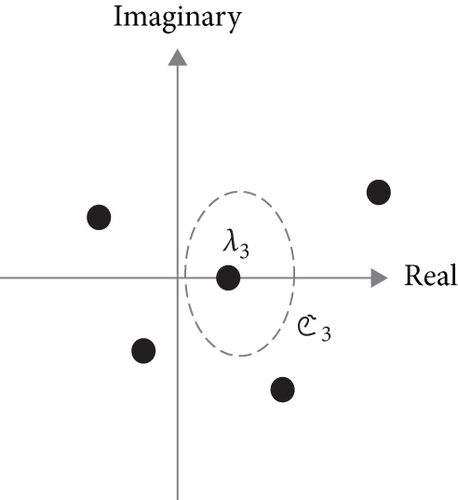
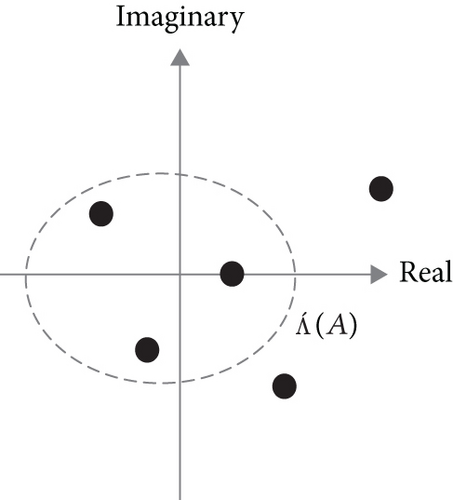
3.2. Generalized Cauchy’s Residue Theorem for Tensor Sequences
Lemma 6. If has a simple pole at and can be expressed by
Proof. Since we have
Lemma 7. If has a pole at with a multiplicity k ∈ ℕ, then we have
Proof. We have
Assume . We get
Thus, according to Eq. (63), Lemma 7 is proven.
Lemma 8 below governs the contour integral of the powers of .
Lemma 8. We get
Proof. For n ∈ ℤ and n ≥ 0, since we have
Eq. (71) is valid by the binomial expansion of . For n ∈ ℤ and n < −1, since we have
Consequently, Lemma 8 is proven.
Now we present Cauchy’s residue theorem for tensor sequences as Theorem 9 below.
Theorem 9 (Cauchy’s residue theorem for tensor sequences). If ℭ is a simple closed contour in the complex z-plane and f(z) is an analytic function with the tensor coefficients except for some tensors with the corresponding spectra , , …, inside the contour ℭ, then we have
Proof. Assume that m = 1 and is a simple pole. Thus, we can express f(z) by
By integrating both sides of the following identity:
According to Theorem 4 and Lemma 8, we have
In general, let be an ROC in the complex z-plane containing a contour ℭ and be a subregion of without any of the spectra , , . Consider that these spectra (poles) , , are inside the contours (say small circles) ℭ1, ℭ2, …, ℭm, respectively, such that ℭ − (ℭ1 + ℭ2+⋯+ℭm) is inside where “-” and “+” here specify the set difference and union operators, respectively. Theorem 9 is thus proven by applying Theorem 4 and Lemma 8 subject to in both Eqs. (57) and (72). The residue tensors , k = 1, 2, …, m, can be obtained using Lemma 6 if is a simple pole or Lemma 7 if has a multiplicity larger than one.
4. Inverse Tensor z-Transform
In this section, we will introduce two approaches to undertake the inverse tensor z-transform. First, the power-series approach (or long-division approach) will be introduced in Section 4.1 while the contour-integral approach based on our newly derived Cauchy’s residue theorem for tensor sequences will be presented in Section 4.2.
4.1. Power-Series (Long-Division) Approach
Proof. According to the right-hand side of Eq. (83), we have
According to Chapter 3 in [26], the solution space of ’s in Eq. (83) is equivalent to the solution space of the tensor satisfying
According to Section 2.2 in [24], the tensors ’s and all can be “unfolded” to form the corresponding υ × υ unfolded matrices, say Bi’s and Z. The solution space of in Eq. (86) is identical to the solution space of Z in the following:
solutions of such in Eq. (86). If we know the solution of , i = 1, 2, …, n − 1, to Eq. (87), then Eq. (83) becomes
Suppose that we have the following tensor-root decomposition for the denominator polynomial in Eq. (82):
Consequently, the rational tensor z-function given by Eq. (82) can be expressed by
Furthermore, we can rewrite Eq. (93) to split into the causal and anticausal parts as the following
An example to illustrate how to apply the power-series approach, i.e., long division, to carry out the inverse tensor z-transform is presented below.
Example 2. Here, we will present an example to illustrate how to apply the power-series approach, i.e., long division, to carry out the inverse tensor z-transform. Suppose that is a rational tensor z-function, which can be expressed by


According to Eq. (93), we can express by
Note that we can obtain the coefficient tensors , and as given by Eq. (94) such that

According to the power-series approach to undertake the inverse tensor z-transform, we have

Thus, according to the power-series method, we have
Again, according to the power-series approach to undertake the inverse tensor z-transform, we have

Finally, by the linearity of the z-transform, we have

where and are given by Eqs. (105) and (108), respectively.
Because the eigenvalues of the tensor are 1/2, 1/2, 1/3, and 1/3 while the eigenvalues of the tensor are 1, 1, 1/2, and 1/2, we can determine according to Eq. (96) such that
4.2. Generalized Contour-Integral Approach
Theorem 11. Let be an analytic function except for the positions at the pole tensors , , …, with the corresponding spectra: for j = 1, 2, …, Jk and k = 1, 2, …, m. We have τ contours; i.e., ℭi, i = 1, 2, …, τ, and all pole tensors’ eigenvalues inside ℭi are collected as the set such that
If we assume that
Proof. We select a large contour ℭ∞ that includes all eigenvalues belonging to . Thus, in extension of the inverse (scalar) z-transform study in Section 3.4.1 of [28], we obtain
Suppose that we want to carry out the inverse tensor z-transform of given by Eq. (95) using the generalized contour-integral approach subject to a closed contour ℭ such that , k = 1, 2, …, m, denote the spectra inside ℭ. If there are Jk eigenvalues included in the spectrum , then the ROC of the tensor z-transform given by Eq. (95), denoted by , can be expressed by
The inverse tensor z-transform via the contour-integral approach can help us to establish the “generalized Parseval’s relation,” given two tensor-sequences, say and with the corresponding tensor z-transforms as given by
According to the generalized contour-integral approach stated in this subsection, we have
Therefore, we establish the generalized Parseval’s relation below for tensor sequences:
An example to illustrate how to apply the generalized contour-integral approach to undertake the inverse tensor z-transform is presented below.
Example 3. In this example, we will illustrate how to employ the generalized contour-integral approach to undertake the inverse tensor z-transform. A rational tensor z-function is given by

According to Eq. (119), the eigenvalues and the eigentensors of the pole tensor are given by
Similarly, the eigenvalues and the eigentensors of the pole tensor are given by
If we consider the inverse tensor z-transform as a causal tensor-sequence subject to a contour ℭ which is any simple closed curve in the region: |z| > 4, and includes the spectrum {1, 1, 2, 2} of the pole tensor and the spectrum {3, 3, 4, 4} of the pole tensor , we have

Furthermore, if we consider the inverse tensor z-transform as a causal tensor sequence subject to another contour which is any simple closed curve in the region: 3 < |z| < 4, and includes the spectrum {1, 1, 2, 2} of the pole tensor and a partial spectrum {3, 3} of the pole tensor , we have

Note that we only involve the eigenvalues 3, 3 here because the contour does not include the eigenvalues 4, 4.
5. Applications of Tensor z-Transform
In this section, we will introduce two applications of our proposed tensor z-transform, namely, “tensor filters.” Tensor filters can be widely adopted to characterize massive MIMO (multi-input multioutput) linear-time-invariant (LTI) systems [29–33].
5.1. Infinite-Impulse-Response (IIR) Tensor Filters
The block diagram given by Figure 1 illustrates how to realize a GARMA-(n, m) filter.
The block diagram illustrated by Figure 3 demonstrates how to implement the aforementioned GARMA-(n, n) filter formulated by Eqs. (130) and (131).
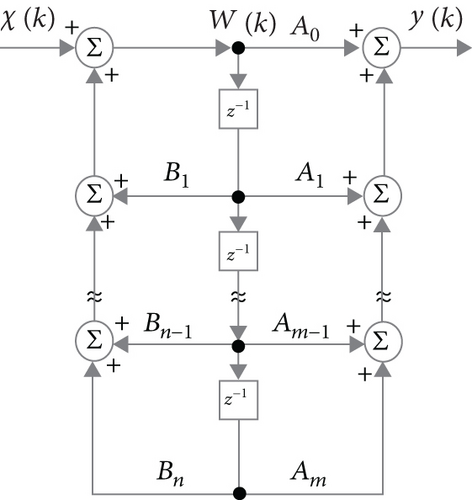
5.2. Finite-Impulse-Response (FIR) Tensor Filters
The block diagrams (for the direct forms I and II) illustrated by Figure 4 demonstrate how to implement the aforementioned m-th order FIR tensor filter formulated by Eq. (132).


6. Numerical Evaluation
In this section, we will present the numerical evaluation for an IIR tensor filter. The corresponding frequency and phase responses will be discussed in Section 6.1 while the approximation of discrete-time tensor signals through our proposed spectral-selection technique along with the implementation-complexity analysis will be investigated in Sections 6.2, and Section 6.3, respectively.

6.1. Frequency and Phase Responses
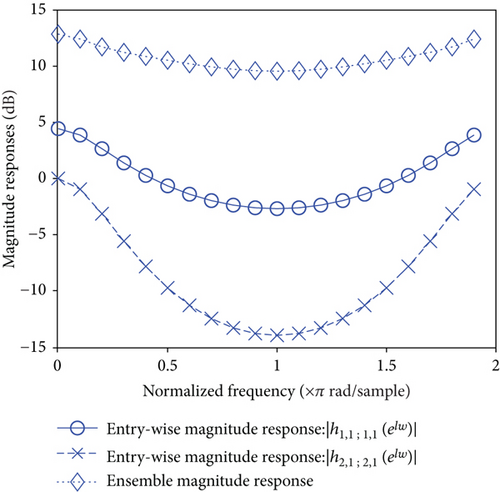
Figure 6 plots the phase responses of the IIR tensor filter characterized by Eq. (134). Two entry-wise phase responses and together with the ensemble phase response, denoted by “Ensemble,” are depicted by Figure 6.

6.2. Approximation of Discrete-Time Tensor Signals via Spectral Selection
According to Section 4.2, we can obtain different inverse tensor z-transforms by selecting different eigenvalues within an integration contour. The norm (the tensor norm is defined in Section 2 of [3]) of the coefficient-tensor at the n-th time index (tap) produced by the inverse tensor z-transform (the transfer tensor) of the IIR tensor filter characterized by Eq. (134) (such that ) is depicted in Figure 7. Let represent the eigenvalues of the pole tensor as highlighted in Eq. (134) enclosed by a contour ℭ selected for the inverse tensor z-transform.
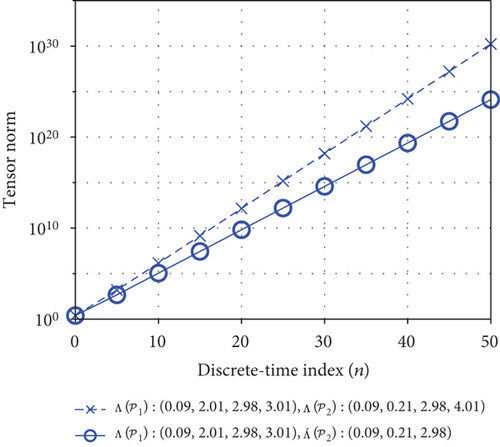
Similarly, let represent the eigenvalues of the pole tensor in Eq. (134) enclosed by a contour C for the inverse tensor z-transform. The red bar-graph in Figure 7 depicts the tensor norms of the inverse tensor z-transform subject to a contour ℭ enclosing the spectra and . Now let us change to and the green bar-graph in Figure 7 depicts the tensor norms of the inverse tensor z-transform subject to a contour ℭ enclosing the spectra and . Note that the tensor norms marked in green are always less than those marked in red with respect to discrete-time indices n since the former tensor norms result from the spectrum of the pole tensor without an eigenvalue 4 in comparison with the latter tensor norms. The legend of Figure 7 denotes the eigenvalues of the two pole tensors and inside a selected contour ℭ.
Given ℌ(z), , and , define the “approximation-error-norm tensor sequence” , where ℭ encloses all eigenvalues of all pole tensors but ℭ′ leaves out some of them.
Figure 8 depicts the “approximation-error norm” with respect to the discrete-time index n subject to three different contours ℭ′, where the symbol “⋄” in the figure indicates that ℭ′ encloses the spectra and , the symbol “°” in the figure indicates that ℭ′ encloses the spectra and , and the symbol “×” in the figure indicates that ℭ′ encloses the spectra and .
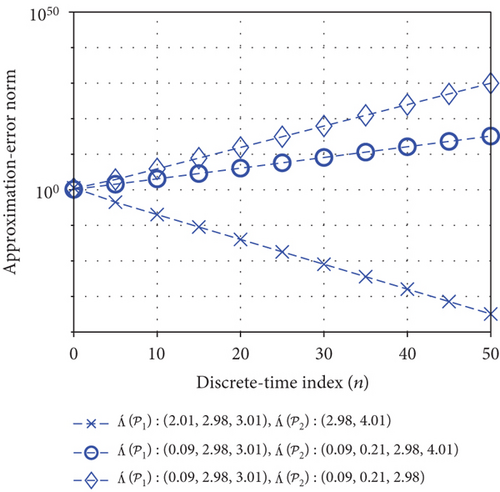
Now we define a “principal eigenvalue” λ such that |λ| > 1 where or . Similarly, we define “minor eigenvalues” λ such that |λ| < 1 where or . According to Figure 8, we observe that the approximation-error norm delineated by the symbol “⋄” is the largest at every k because two repeated principal eigenvalues 2 of the pole tensor and a single principal eigenvalue 4 of the pole tensor are not involved in the contour integral for the inverse tensor z-transform. On the other hand, the approximation-error norm delineated by the symbol “×” is the smallest at every n because all principal eigenvalues (except some minor eigenvalues) of the pole tensors and are involved in the contour integral for the inverse tensor z-transform. As a matter of fact, the approximation-error norm delineated by the symbol “×” will converge to zero as the discrete-time index n approaches ∞. This phenomenon implies the flexibility of our proposed tensor z-transform for the application of approximating an IIR tensor filter characterized by Eq. (125) by another IIR or FIR tensor filter.
6.3. Computational-Complexity Study of Inverse Tensor z-Transform
where and denotes the i-th involved pole tensor with the associated coefficient tensor . If we apply the recursion procedure to carry out Eq. (138), the required computational complexity is given by in terms of the Big-O notation. If we just involve ζ principal eigenvalues inside the contour ℂ to approximate a pole tensor , the required computational complexity is given by since there are υ elements in each eigentensor. Figure 9 depicts the computational complexities required for carrying out Eq. (138) with respect to the entry-size I1 (note that I1 = I2 = ⋯IM) using the contour-integral subject to the contours enclosing (i) all eigenvalues of all pole tensors (denoted by “○” in the figure), (ii) two eigenvalues of all pole tensors (denoted by “×” in the figure), and (iii) four eigenvalues of all tensors (denoted by “+” in the figure), respectively. The approximation approach can reduce computational complexity significantly according to Figure 9.
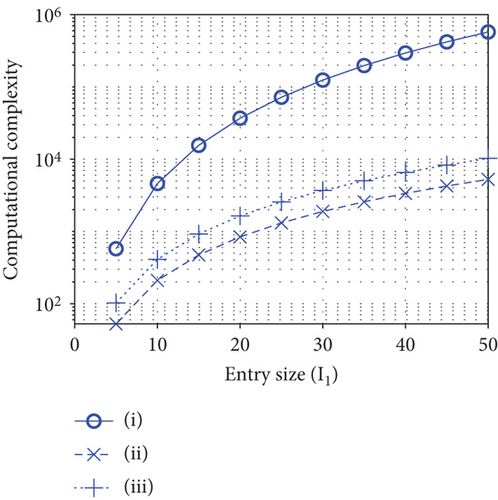
For the memory-complexity study, the exact computation of Eq. (138) requires the memory with the size in terms of the Big-O notation. If we just involve ζ principal eigenvalues inside the contour ℂ to approximate a pole tensor , the required memory complexity is given by since there are υ elements in each eigentensor. Figure 10 depicts the memory complexities required to carry out Eq. (138) with respect to the entry-size I1 (note that I1 = I2 = ⋯IM) using the contour-integral subject to the contours enclosing (i) all eigenvalues of all pole tensors (denoted by “○” in the figure), (ii) two eigenvalues of all pole tensors (denoted by “×” in the figure), and (iii) four eigenvalues of all tensors (denoted by “+” in the figure). According to both Figures 9 and 10, our approximation approach by use of the contour integral involving fewer eigenvalues of the pole tensors inside a contour can greatly reduce the computational and memory complexities required for the inverse tensor z-transform.
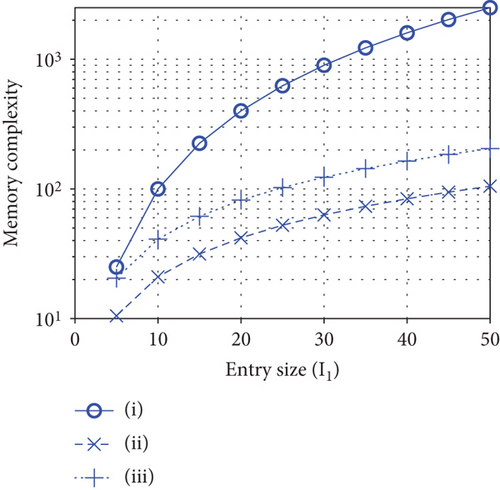
7. Conclusion
In this work, a new arbitrary-dimensional transform, namely, the tensor z-transform, is established to characterize multirelational signals and multi-input multioutput linear-time-invariant systems. The definition of the tensor z-transform is first introduced, and then, the essential mathematical properties are discussed. We extend the conventional Cauchy’s integral formula and Cauchy’s residue theorem for dealing with scalar functions to the new generalized Cauchy’s integral formula and the new generalized Cauchy’s residue theorem for tensor functions. Thus, we propose a new generalized contour-integral approach for undertaking the inverse tensor z-transform. The applications of our proposed new tensor z-transform in this work include the design and approximation of infinite-impulse-response (IIR) and finite-impulse-response (FIR) tensor filters. By selecting the eigenvalues of the pole tensors of a tensor z-transform inside a contour for the inverse tensor z-transform, we can control the corresponding approximation-error norm and the required computational/memory complexity. Our proposed novel tensor z-transform framework can facilitate a promising analysis tool for signal and information processing over networks in the future.
Conflicts of Interest
The authors declare that they have no conflicts of interest.
Acknowledgments
This work was supported by the Louisiana Board of Regents Research Competitiveness Subprogram under Grant LEQSF(2021-22)-RD-A-34.
Open Research
Data Availability
No underlying data was collected or produced in this study.




